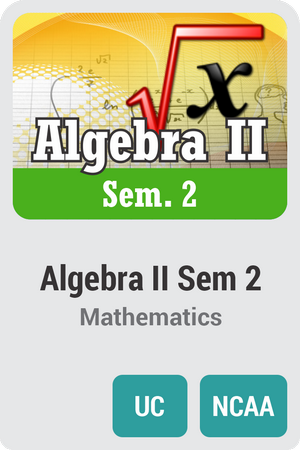
Course Overview:
Algebra 2 reviews and builds on topics discussed in Algebra 1. Topics introduced in Algebra 2 provide an introduction to topics that will be presented in more rigorous college prep math courses. This course emphasizes expanding critical thinking and problem-solving skills. Using technology as a tool is incorporated into the course.
Semester 2 explores exponential, log and trig functions. Students will simplify and graph these functions by hand and using technology. Students will model real world data with functions. Data collection methods, central tendency and dispersion are presented. The normal curve is studied. Two-variable data sets are analyzed and the function of best fit is determined and used to make predictions.
Note: This course is not designed for ELL (English Language Learners) students. ELL students may enroll in this course ONLY if they have adequate mentor support at their home school and are able to fulfill all course requirements.
Prerequisites:
Required Material:
This course requires practice on GeoGebra and/or Desmos. These are both online free tools. In addition Graph paper may be needed for assignments.
Syllabus:
Semester 2:
Section 1: Exponential Functions
This section extends the study of exponential functions introduced in Algebra 1. Parent exponential functions and their translations are graphed. Base e is introduced and application to compounding interest continuously presented. Complex exponential functions are solved by writing equations with bases. Growth and decay models are used to represent real world situations.
After this section the student will be able to:
- Graph parent exponential function and their transformations.
- Write exponential functions from given information.
- Recognize a geometric sequence as an exponential function.
- Understand that base e is a special exponential function.
- Solve compound continuous interest problems.
- Solve exponential functions.
- Model real world problems with growth and decay functions.
Lessons:
- Writing Exponential Functions
- Changing the Base
- Solving Exponential Equations
- Modeling with Exponential Functions
Sections 2: Logarithmic Functions
This section introduces the student to logarithmic functions as inverses to exponential functions. Log functions are graphed showing intercepts and end behavior. The properties of log functions are presented and used to simplify and evaluate log expressions. Exponential and logarithmic functions are solved using inverse operations.
After this section the student will be able to:
- Recognize log functions as inverse of exponential functions.
- Solve logarithmic and exponential equations.
- Graph parent log functions and their transformations.
- Know and use the properties of logs to simplify log expressions.
- Evaluate logarithmic expressions.
Lessons:
- Logs as Inverse Functions
- Transformations of Log Functions
- Solving Exponential and Logarithmic Equations
- Modeling with Logarithms
Section 3: Trigonometric Functions
This section extends the concepts of right triangle trigonometry learned in Geometry to all angles. The conversion from degree measure to radian measure is presented and the unit circle developed. Trigonometric functions are graphed showing period, midline and amplitude. Trig functions are used to model real world situations.
After this section the student will be able to:
- Graph Trig functions showing period, midline and amplitude.
- Explain the Pythagorean Identities.
- State the domain and range of trig functions.
- Graph translations of trig functions.
- Model real world situations with trig functions.
Lessons:
- Introduction to Trigonometry
- Unit Circle
- Graphing Trigonometric Functions
- Modeling Trigonometric Functions
Sections 4: Data Analysis
This section focuses on data analysis. The different methods of gathering data are presented. Data is analyzed for flaws and biases. Building on prior knowledge of central tendency and standard deviation, normal distribution is discussed. Finding the best fit curve to represent a data set is also presented.
After this section the student will be able to:
- Discern between the different methods of data collection.
- Recognize bias in data collection.
- Discuss randomization in collecting data.
- Find the area under the normal curve using tables or technology.
- Estimate population percentages.
- Find the confidence interval and margin of error.
- Draw conclusions based on statistical analysis of data.
- Fit a function to a data set and use the function to make predictions.
Lessons:
- Data Collection
- Dispersion
- Drawing Conclusions
- Curve Fitting


